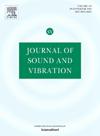Nonlinear interface forces in “breathing” debondings of laminated beams: From formation mechanism to debonding localization
IF 4.3
2区 工程技术
Q1 ACOUSTICS
引用次数: 0
Abstract
Laminated beams have been extensively used in engineering structures due to their enhanced strength and stiffness. However, debondings can occur during manufacturing or service processes, which is a typical form of barely visible damage. Therefore, accurately localizing debondings of laminated beams is crucial for maintaining structural integrity. Within the scope of linear vibration, the existing linear interface forces (LIFs), which are distributed along interfaces between two layers of a laminated beam, feature the capability of locating an open debonding, but are not applicable to a “breathing” debonding with contact behaviour. To address this limitation, this study extends the LIFs to the realm of nonlinear vibration, by which the nonlinear interface forces (NIFs) are formulated based on the equation of nonlinear transverse motion of a beam layer. Opposite to the LIFs, which appear at the intact locations only and vanish within the open debonding region, the NIFs introduced in this study appear exclusively within the “breathing” debonding region, acting as multi-tone harmonic excitation sources to produce higher harmonics. Thereby, the mechanism of generating nonlinear harmonics by NIFs can be analytically expounded. Additionally, this study highlights the use of NIFs for the localization of debondings in laminated beams due to their inherent merit of localization. Particularly, the NIFs are reconstructed from nonlinear operating deflection shapes of a laminated beam in the absence of its material and structural parameters. The capability of the NIF approach for localizing “breathing” debondings in laminated beams is numerically verified using the finite element method and experimentally validated using a scanning laser Doppler vibrometer. The results reveal that the approach is capable of characterizing the occurrence, locations, and sizes of the debondings.
求助全文
约1分钟内获得全文
求助全文
来源期刊

Journal of Sound and Vibration
工程技术-工程:机械
CiteScore
9.10
自引率
10.60%
发文量
551
审稿时长
69 days
期刊介绍:
The Journal of Sound and Vibration (JSV) is an independent journal devoted to the prompt publication of original papers, both theoretical and experimental, that provide new information on any aspect of sound or vibration. There is an emphasis on fundamental work that has potential for practical application.
JSV was founded and operates on the premise that the subject of sound and vibration requires a journal that publishes papers of a high technical standard across the various subdisciplines, thus facilitating awareness of techniques and discoveries in one area that may be applicable in others.
 求助内容:
求助内容: 应助结果提醒方式:
应助结果提醒方式:


